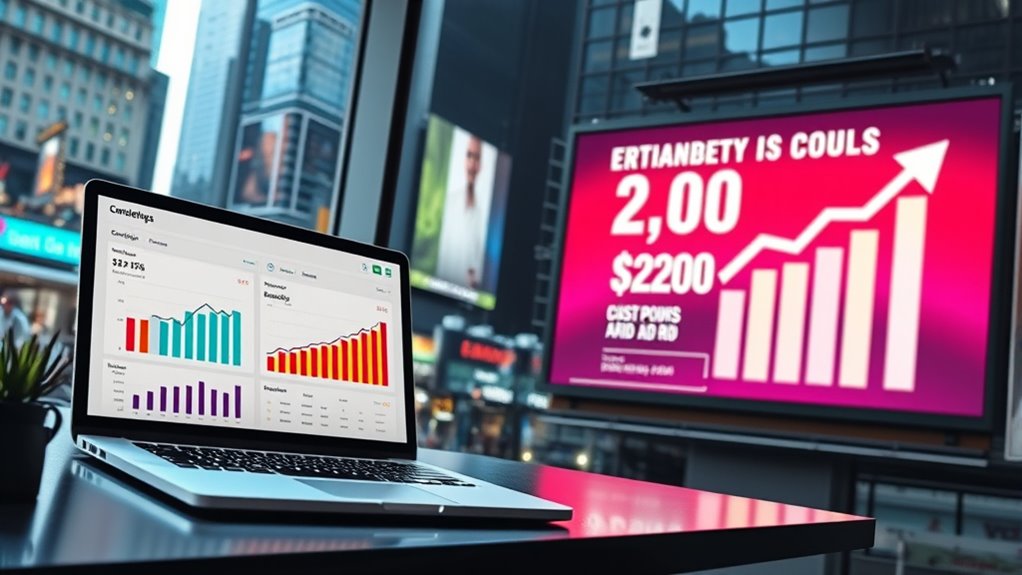Email marketing often delivers a higher return on investment and lower ongoing costs than paid ads. Once you’ve built a quality list, expenses mainly go toward creative updates and segmentation, making it more affordable over time. Paid ads require a larger upfront spend and ongoing optimization, which can get costly without guaranteed results. To discover how combining these strategies can boost your growth and engagement, keep exploring the details.
Key Takeaways
- Email marketing typically has lower ongoing costs and offers better long-term ROI than paid ads.
- Paid ads require larger upfront investments and ongoing budget for optimization, making them more expensive short-term.
- Segmentation and personalization in email campaigns boost engagement efficiently without significant extra costs.
- Paid ads deliver immediate traffic but depend on continuous reinvestment, whereas email marketing builds sustainable engagement.
- Combining both strategies can maximize growth, leveraging email’s cost-effectiveness and paid ads’ quick results.

Are you trying to decide between email marketing and paid ads to boost your business? Both options can be powerful tools, but understanding their cost-effectiveness and return on investment (ROI) is essential for making the best choice. One key factor that influences email marketing’s success is segmentation strategies. When you segment your email list effectively, you deliver more targeted content to specific groups, increasing engagement and conversions. For example, you can segment based on past purchases, geographic location, or engagement levels. This personalization helps you avoid sending generic messages that might get ignored, ultimately boosting your ROI. Alongside segmentation, creative design plays a critical role in email marketing. Well-designed, visually appealing emails grab attention and encourage recipients to click through. Clear calls-to-action, eye-catching images, and mobile-friendly layouts enhance the user experience, making your campaigns more effective without substantially increasing costs. When you combine smart segmentation strategies with compelling creative design, your email marketing efforts become more efficient, delivering better results for less money. Additionally, understanding the antioxidant properties of your content can help tailor health-related campaigns that resonate more with health-conscious consumers. Paid ads, on the other hand, often require a larger upfront investment, especially if you’re using platforms like Google Ads or Facebook Ads. The costs can add up quickly, and while paid ads can generate immediate traffic, their ROI depends heavily on how well your campaigns are optimized. You’ll need to continuously monitor and tweak your ad copy, targeting parameters, and bidding strategies to guarantee you’re getting the most out of your budget. Unlike email marketing, where once your list is built, your costs are mostly related to ongoing creative updates, paid ads demand ongoing spending to maintain visibility. This can make paid ads more expensive over time, especially if your campaigns aren’t delivering the expected results. However, paid ads can produce quick wins, especially for new product launches or time-sensitive promotions. In terms of long-term ROI, email marketing often comes out ahead because its costs tend to be lower once you’ve built a quality list, and it allows for continuous engagement. With paid ads, the results are more immediate but can be less sustainable if you don’t keep reinvesting. Ultimately, your choice depends on your budget, goals, and the ability to implement effective segmentation strategies and creative design in your email campaigns. Combining both approaches can also be a smart move, using paid ads to grow your email list while nurturing leads through targeted, well-designed emails.
Frequently Asked Questions
How Do Seasonality and Market Trends Affect ROI Comparisons?
Seasonality impacts your ROI comparisons by causing fluctuations in campaign effectiveness during certain times of the year. Market trend shifts further influence ROI, as consumer preferences and behaviors change rapidly. When these factors align, your returns from email marketing or paid ads can vary markedly. Monitoring seasonality impacts and market trend shifts helps you optimize your strategies, ensuring you allocate resources effectively and maximize ROI regardless of external fluctuations.
What Are the Long-Term Branding Benefits of Each Strategy?
You’ll build long-term brand loyalty and recognition through email marketing by nurturing your audience with personalized content, fostering trust over time. Paid ads boost brand recognition quickly but may not create lasting loyalty unless paired with consistent messaging. Both strategies strengthen your brand’s presence, but email marketing’s ongoing engagement helps cement your brand in customers’ minds, leading to sustained loyalty and recognition that benefit your business long-term.
How Do Audience Targeting Options Differ Between Email and Paid Ads?
Did you know that 80% of marketers say segmentation strategies boost targeting precision? When comparing audience targeting options, email marketing allows you to segment based on customer data, preferences, and behaviors, creating highly personalized campaigns. Paid ads, however, offer advanced targeting options like demographics, location, interests, and even device type. This makes paid ads more precise in real-time, while email marketing excels in nurturing existing relationships with tailored messaging.
What Metrics Best Measure Success Beyond Immediate ROI?
You should track engagement metrics like open rates, click-through rates, and social shares to gauge ongoing interest. Additionally, assess conversion quality by analyzing the depth of interactions and customer retention. These metrics reveal how well your content resonates and whether your efforts lead to meaningful customer relationships. Focusing on engagement and conversion quality provides a clearer picture of long-term success beyond immediate ROI.
How Does Customer Lifetime Value Influence Overall Cost-Effectiveness?
Customer lifetime value (CLV) substantially impacts your overall cost-effectiveness by emphasizing customer retention through targeted customer segmentation. When you focus on high-value segments, you can improve purchase frequency and maximize ROI. By nurturing loyal customers, you reduce acquisition costs and increase revenue over time. This approach ensures your marketing efforts are more efficient, ultimately boosting your profitability and helping you make smarter budget decisions for sustained growth.
Conclusion
Ultimately, choosing between email marketing and paid ads depends on your goals and budget. Both can be powerful tools when used wisely, but don’t put all your eggs in one basket. You need to strike a balance to get the best bang for your buck. Remember, it’s not about throwing money at the wall and seeing what sticks, but about making smart moves that yield real results. Play your cards right, and you’ll see your ROI grow.










